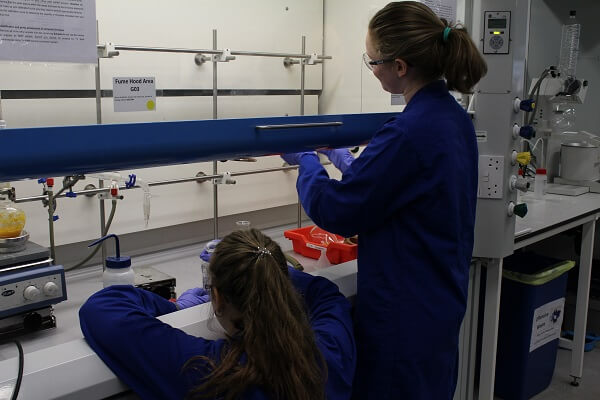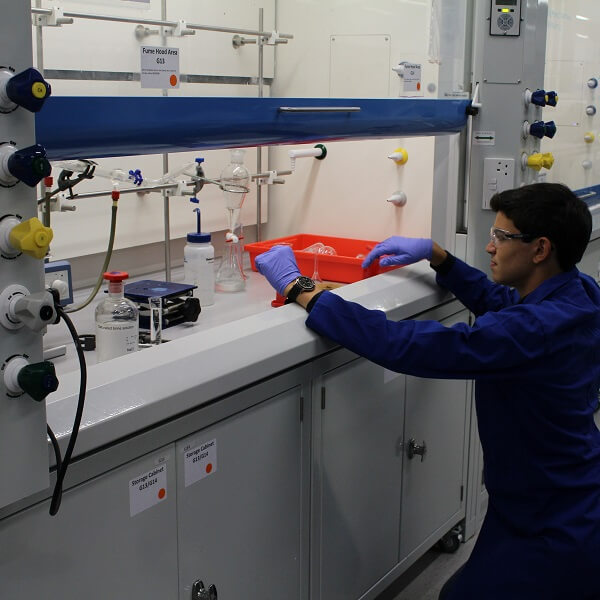
Upper Sixth A level Chemistry students started their new school year with a workshop in the Chemistry Department at the University of York.
The visit was a valuable opportunity for the students who were interested in studying chemistry or a science related subject at university, to work in the teaching laboratories at the University and develop their knowledge and confidence with practical skills they have learnt at school. The students were divided into groups and were set the challenge of carrying out an undergraduate procedure – the extraction of limonene, a plant oil.
Upper Sixth student Phoebe Witty, who is the Pocklington School subject assistant for Chemistry, gave the following account of the workshop:
‘Although initially the trip felt like any other school outing for the students, there were many aspects that made it stand out. Upon arrival we received the warmest of welcomes and began our journey through the labs immediately where we met Dr Phil Helliwell and Dr Liza Binnington. Not only were the students amazed by the high standards of the laboratories and their wide range of facilities and equipment but also the helpfulness of the staff.
Following a laboratory briefing by Dr Helliwell we began our independent journey with our lab partners to quantify a cyclic monoterpene, labelled Limonene (C10H16), naturally occurring in citrus fruits and adapted for use in cleaning products, pharmaceuticals and agricultural compounds.
With each pair given their own fume cupboard and working area it was easy and straightforward to begin the experiment. We began by zesting either a lemon or an orange, weighing the shavings and adding them to a round bottom flask (250ml) with a stirrer bar and 100ml of distilled water. The stirrer bar was a new find for most of the students, having never seen one before. This interestingly “stirs” the contents of the flask by conducting a magnetic field with the heater. Next, we proceeded to heat and stir the solution after carefully setting up a simple distillation apparatus with the aid of several plastic joining clips.
We then collected 50ml of the distillate and added it to a separating funnel with 25ml of ethyl acetate - often found in glue, nail polish remover and decaffeinated tea and coffee. We then shook the funnel to mix the solutions before draining off the aqueous layer and adding 20ml brine before, shaking the funnel and draining the aqueous layer again. This procedure was then repeated twice more.
 We dried the organic layer using a spatula to add Magnesium Sulphate (MgSO4) into a beaker (100ml) and then filtered off the solvent. To ensure all of the desired compounds were obtained, we washed the beaker with ethyl acetate. Thereafter, we poured the filtrate into another round bottom flask (100ml) and placed it in a Rotary Evaporator to remove the solvent. This left us with a drop amount of our solution of which we added 3ml of ethyl acetate and added to a volumetric flask (10ml), then repeating the addition of 3ml of ethyl acetate twice. We then allowed the bottom of the meniscus to reach the line using additional ethyl acetate. This entire process took roughly 2 hours, but time seemed to move quicker in the lab.
We dried the organic layer using a spatula to add Magnesium Sulphate (MgSO4) into a beaker (100ml) and then filtered off the solvent. To ensure all of the desired compounds were obtained, we washed the beaker with ethyl acetate. Thereafter, we poured the filtrate into another round bottom flask (100ml) and placed it in a Rotary Evaporator to remove the solvent. This left us with a drop amount of our solution of which we added 3ml of ethyl acetate and added to a volumetric flask (10ml), then repeating the addition of 3ml of ethyl acetate twice. We then allowed the bottom of the meniscus to reach the line using additional ethyl acetate. This entire process took roughly 2 hours, but time seemed to move quicker in the lab.
Following lunch, we proceeded to the final stage of the quantification; Gas Chromatography (GC). To many of the students, this was one of the most exciting experiences of the day, having never before used a GC. Excluding our sample, we analysed 3 other samples including; 10mg, 20mg and 50mg, gathering their concentration (mgml?¹) and the area they covered on the GC. We used a hypodermic needle to insert the samples into the chamber.
The final stage was to create a line graph of the data collected from the three samples, identifying a trend line with an equation which enabled us to calculate the concentration of limonene found in our samples.
Although the process was lengthy and required accuracy and precision in application, the day was considered a success with everyone finding a range of concentrations of limonene in their samples. It was a rewarding experience, not just enjoyed by the students but hopefully by the staff who attended from Pocklington School and the dynamic duo, Dr Halliwell and Dr Bennington who oversaw us.
Mrs McDowell, Head of Chemistry at Pocklington School, said: "The students gained a valuable experience of working in the teaching laboratories at the University of York and were able to use equipment they learn about while studying A-level chemistry. We look forward to returning again in the future."


